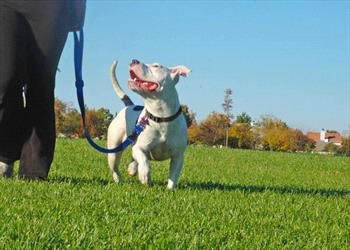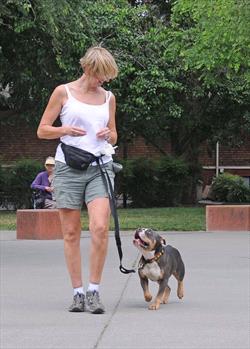It’s week 1 of our quarterly 7-week dog class and we have some fun and exciting updates in store.
First, this quarter two of our student employees, Lynna and Lauren, get to teach one exercise each week. That allows me and co-instructor, Melissa Morris, CPDT-KA, to assist with the demo so that there are more “demonstrators” for the participants to watch. It also allows us to test out our curriculum for training new instructors to teach our specific training program.
As usual, the set of classes started off with our introductory workshop-game show. In this workshop, we find out about our participants’ dog issues and we cover four learning modules.
- Module 1 is on the body language of anxiety and fear.
- Module 2 is on the two-step process for fixing behavior problems.
- Module 3 is on “How Fido Learns,” where we touch on timing, shaping, motivation, communication, the importance of leading like a partner in a dance, the first 2 exercises we will teach in dog class, and videos on how we measure handler technique.
- Module 4 is on developing impulse control through the Learn to Earn program which we implement fully in Week 5.
Each section ends in a 3–5 minute session where participants, in groups of 4–5, can go over discussion questions before we start our rapid-fire game show quiz with prizes for the group that gets the most answers right. This quiz helps us learn what participants are taking out of the presentations and where we need to modify our delivery to get our main messages across. It also makes the learning process fun for the audience.
Says one participant, Becca Hintz,
LOVED the lecture last night! And happy to have been on team two! I have to say, I have attended a lot of animal lessons (competitive dressage and eventing background), clinics, etc paying $500.00 for a lesson and have NEVER had such thorough, competent, effective teaching. Loved the welcome bag with info we can take home and use for this class but continue to learn from and use with our current dogs and future dogs. I love that we have homework! I teach riding lessons and give my kids homework. I am so excited to continue to learn from this class!
We had so many enrollees (and their family members) that we are teaching two classes with 8–10 each instead of just one. Each class has a variety of dogs ranging from Bichon to Mastiff with a handful of pit bull-type dogs interspersed. Here is the progression of exercises we performed on day 1. For those who came to the Reactive Dog Workshop on Oct 13, you’ll see that this progression looks familiar! We use it for regular dogs as well as reactive dogs, which is why we are also able to easily integrate some reactive or hyperactive dogs in our class.
Exercises day 1:
- Posture and treat delivery speed (human-only exercises to prep for say please by sitting)
- Backwards movement exercises (human-only exercises to prep for repeat sit backwards)
- Say please by sitting (human-dog teams)
- Repeat sit backwards (human-dog teams)
- Repeat sit backwards away from distractions—distraction level and type varies with dog ability. Dog-reactive dogs worked with Jonesy in close proximity. Goal = stay under threshold. Owners learn correct timing and direction to move to keep their dogs happy, focused and behaving politely.
- Leave-it: food on the ground (dog handler teams). This is the first impulse control exercise.
- Watch me (using a smooch instead of a word): From How to Behave So Your Dog Behaves (Ch. 17)
How the dog-owner teams performed
Dogs did quite well for the first day. Reactive Lhasa Apso mix, Boo, who came to our reactive dog workshop on October 13th, was able to work within 10 feet of other dogs. Previous to the reactive dog workshop, Boo would bark and lunge as soon as he saw dogs far off in the distance.
Koa, who was barking at all of the excitement and to get back to her owners during the human-only exercises, was able to focus even with dogs within 10–15 feet by the end.
Buddy, the Nova Scotia Duck Tolling Retriever, found out that his junior trainer was really fun and he could get lots of rewards by keeping his undivided attention on her. Now we’ll see if the other junior trainers in the household will be as diligent and successful!
And we identified 4 of the dogs who are overly anxious when separated from their owners—meaning if one owner walks away from the other they whine until that owner comes back, and it doesn’t matter which one just walked away. Then, when their owners are together, they aren’t overly concerned and focused on them, they just get anxious when one walks away. We use several variations of say please by sitting and leave-it at the end of the leash to quickly teach these dogs to be calm and show impulse control in these very situations! We’ll probably get to these by week 3 or 4.
Owners have to practice what they learned!
Of course, the actual first class is just the start. The next step is that the owners practice at home. Here’s a look at the homework and support materials they receive.
| 1 | Repeat Sits Backwards |
Perfect Puppy Ch.5.2.1–5.2.2 p.77–80 |
Dog Workshop demo Ch. 1 The Basic Say Please by Sitting Excercise |
|
| 1 | Leave It (End of Leash) | Dogs Who Eat Things Off the Ground: Training Leave It (Version 1)
Perfect Puppy Ch.5.4.3 p. 104–107 |
Training a Dog to Leave It (Version 1)
Training a Dog to Leave It (Version 1) |
|
We’ve also sent them our training protocols broken into little shaping steps so they can check off their successes as they improve.
| STEP | CRITERIA |
| Step 1 | BASIC SAY PLEASE BY AUTOMATICALLY SITTING (and looking at you)
INSTRUCTIONS:
CRITERIA for CORRECT RESPONSE:
HANDLER TIPS:
|
| Step 2 | INCREASING INTERVAL BETWEEN TREATS WHILE SITTING
INSTRUCTIONS:
CRITERIA for CORRECT RESPONSE: Rover must reliably sit within 2 seconds and must remain watching you for up to 5 seconds in between treats until you give your release word “free” or until you move on to another exercise. HANDLER TIPS: Remember to vary the interval between treats and still deliver the treats. |
And we have a Facebook group just for our attendees so they can show their successes. Jonesy posted his own success on step 5 of our leave-it exercise: Proofing the leave-it cue. Here he shows even when there are multiple treats on the ground and he’s allowed to pick up one, he has enough impulse control that he can “hear” when I tell him “leave-it” right as he’s going for the second treat! Yay Jonesy! You can tell he doesn’t look deprived. In his mind, leave-it means he may get a chance to get the treat on the ground. In reality, he never knows which time he’ll get a reward for this behavior because he’s on a variable schedule of reinforcement.




